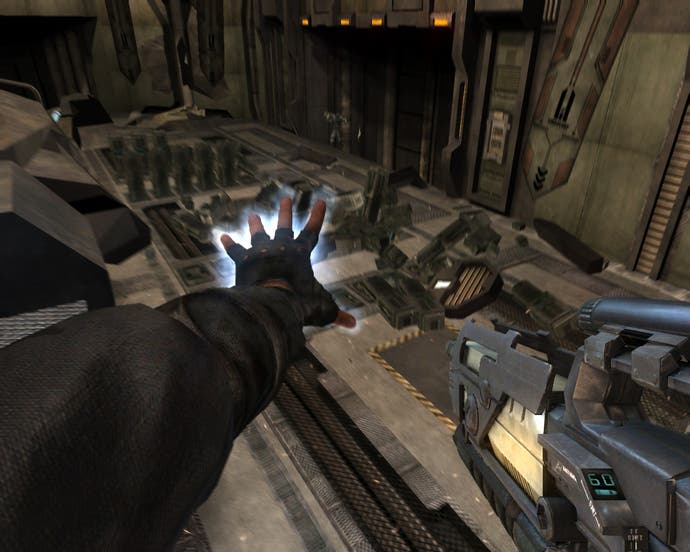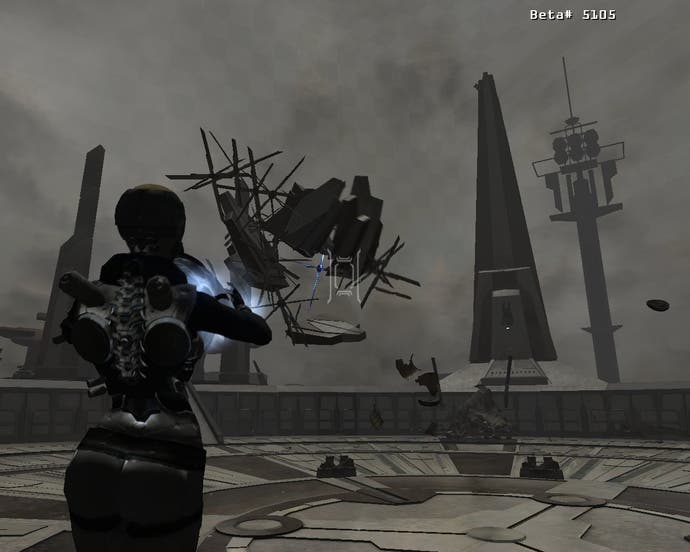CellFactor: Revolution
Set calculators to 'physics'.
CellFactor: Revolution isn't your everyday deathmatch shooter. For starters, it's free. Today, as it happens. For seconds, it's essentially interactive propaganda, conceived by hardware manufacturer Ageia as an advert for its PhysX PPU (physics processing unit). We'll get to the game in a bit, but to begin with, a little background, because it's arguably much more interesting than CellFactor itself.
You see, Ageia has a rather unusual problem.
The company was formed in 2002 around the notion that the next big thing in gaming processors would be dedicated physics hardware. One day, it dreamed, physics would form such an essential part of the gaming experience that physics cards would sit alongside the ubiquitous graphics cards in gaming PCs - and, who knows, maybe even consoles.
These chipsets would take the strain of heavy physics calculation off CPUs, much as graphics cards stepped in to do in the early days of 3D acceleration. They would also benefit from a fast two-way data exchange with the processor, meaning they could provide gameplay-critical, interactive physics, rather than the purely cosmetic effects that a physics accelerator mounted on a graphics card could. And they would all be manufactured by Ageia, because it had spotted the market opportunity first. Thus, the PhysX card was born.
The thing is, in order to sell hardware, Ageia had to move into software too. It had to create a physics middleware library - a toolkit for developers, so they wouldn't have to do their own complex and time-consuming physics programming, or worry about how to make it compatible with the PhysX chip. This library, also called PhysX, put Ageia in competition with established names in physics middleware, like Havok.

The difference is that Ageia isn't charging for its middleware on PC - it plans to make its money from the cards instead, reasoning that the more PhysX-compatible games are out there, the more chips it can sell. That's sound logic, except that when it comes to consoles, Ageia can't sell cards, so it just licences the middleware in the traditional way instead. And lo and behold it's doing rather well on its own, getting it into games like Gears of War, Red Steel and the latest Tom Clancys. These are much bigger hitters than the PC releases to date - Bongfish's Stoked Rider, anyone? Bet on Soldier: Blackout Saigon? - although PhysX's foothold in the Unreal and Bioware engines will eventually bring along desktop blockbusters like Dragon Age and Unreal Tournament 3.
So Ageia finds itself fighting a battle on three fronts: with Havok; with graphics card manufacturers NVIDIA and ATI (who, spotting a trend, are now cramming physics processors onto their products); and bizarrely, with itself. Because if the PhysX middleware is so good, do you really need the card to go with it?
To sort this mess out, Ageia needed to make a statement: to get a game out there, on as many PCs as possible, that would clearly demonstrate the performance gap between PhysX with the processor and without it. CellFactor: Revolution, a free download from www.cellfactorrevolution.com, is that game.
Developed for Ageia by Immersion Games and Artifical Studios, it began life as a tech demo for the PhysX card, but after a positive response at last year's E3, was then extended into something approaching a full game. It's a first-person deathmatch shooter with three character classes (two with physics-manipulating psi powers) and five maps. Four maps will run acceptably if not smoothly on a machine with no PhysX card, the fifth being an extremely physics-heavy showcase for Ageia's hardware that grinds down to a frame a second without the PPU. If you have a PhysX card, you can turn it off in the options to see proof of the difference its grunt makes.

There's a single-player Campaign mode which sets a number of challenges (e.g. kill ten bots using psi powers only) for each map, plus a fairly standard set of Skirmish options - Deathmatch, Team Deathmatch, Capture the Flag and bomb-delivering Assault. In skirmishes you can opt for AI opposition (sharp-shooting, if a bit static) or play 8-player matches over LAN. However, the sheer amount of data that CellFactor needs to throw around has made online multiplayer impossible. That, it must be said, severely limits the game's appeal as anything more than a PhysX demo.
Of the three classes, the Guardian is the bread-and-butter, running-and-gunning grunt. The Black Ops combines weapons with the ability to use vehicles, gravity grenades and basic psi powers, including a satisfying force push which can be used to hurl objects at your foes. The Bishop is the physics star, a flying genetic mutant who can't use weapons, but can push, pull, lift, and crush huge numbers of objects (and people) at a time, fire rapid streams of debris and clear swathes of room with psi waves.
The Bishop has the most entertainment value, but we found her control configuration extremely fiddly, and kills initially quite hard to pull off. Black Ops is the most immediately satisfying choice, not least because of the access it gives (on some maps) to the four chunky and well-realised vehicles: the Goliath mech, Death Stalker car, Dusk Hawker aircraft and self-explanatory Hover Mech.
The maps are standard-issue shooter dystopia - rusting, industrial death pits under bloody skies, all lava and steel and big piles of crates. Really, really big piles of crates you can lift and crush together like they were a crisp packet. And neatly stacked rows of literally hundreds of canisters, just asking to be scattered and battered in seconds with the wave of a Bishop's hand. In terms of the PhysX's raw number-crunching power with rigid-body physics, deformation and collision detection, CellFactor is an impressive demonstration, no doubt.

But these bleak, mechanical settings don't really give it a chance to shine in the other areas Ageia is touting: fluids, fabrics (which includes fibres like hair and grass), and joints and springs. The lava and cobwebs, doing fluid and fabric duty respectively, were especially underwhelming, and didn't show us anything we hadn't already seen done better elsewhere, without hardware acceleration. That's not to say that PhysX isn't capable of serious feats in these areas, just that CellFactor isn't where you'll find them.
As a deathmatch shooter, CellFactor doesn't seem especially well-balanced and is crippled by its lack of an online mode. But it's substantial enough for a freebie, undeniably spectacular at times, and well worth a look if you have either a PhysX card or a fairly beefy PC. As a PhysX demo though, it's frankly a little worrying. There's no denying that the card has clout to spare, and can throw a stupendous number of objects around the screen convincingly. But little of what it makes possible is new, it's just that there's a lot more of it. Is sheer quantity where the future of physics realism really lies?
There are software physics packages out there that can do jaw-dropping stuff without needing a dedicated hardware backup, stuff far beyond what you will see in CellFactor - albeit, admittedly, on a smaller scale. Pixelux's amazing Digital Molecular Matter is one, currently under licence to LucasArts and being applied to its next Indiana Jones and Star Wars titles. DMM simulates the properties and behaviours of all kinds of material - cloth, glass, wood, rubber, crystal - with astonishing accuracy. Scattering a thousand boxes may be pretty, but watching one box splinter and crack in minute detail a different way every time you hit it is something else: it's the shock of the new.
You have to ask yourself: is it the power you're packing, or what you do with it that counts?


.png?width=291&height=164&fit=crop&quality=80&format=jpg&auto=webp)




.jpg?width=291&height=164&fit=crop&quality=80&format=jpg&auto=webp)
